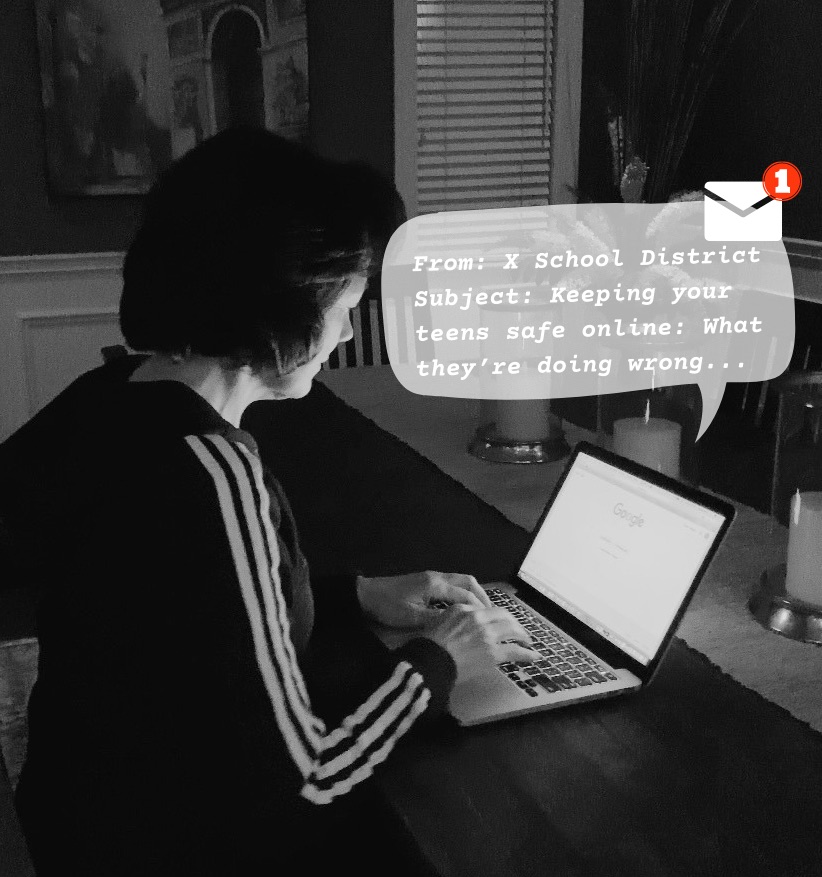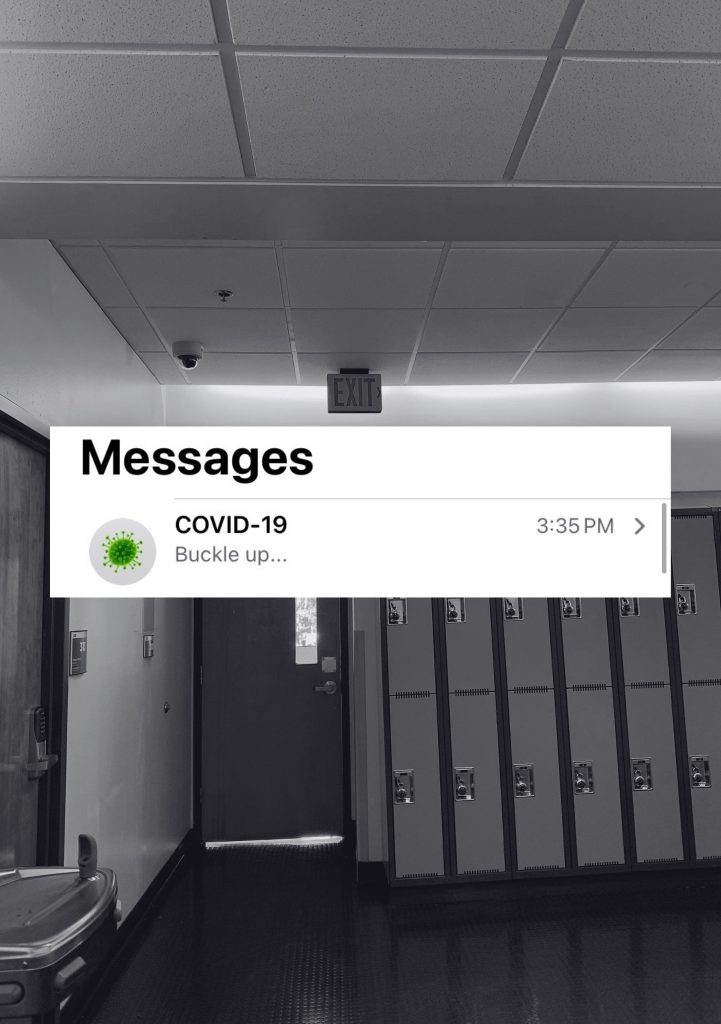
Bianca Salamis
Bianca Salamis is in her final year of her undergrad in the Interdisciplinary Studies program here at Cap U. She started her journey through post-secondary education at the University of Calgary where she studied Political Science and Law. However, it wasn’t until she came to Cap U that she found a place that allowed her to apply her areas of expertise to more local issues! Throughout her degree, she has completed two research projects focused on public issues that stem from cyber and information security policies in Canada.

Personal Narrative
September of 2012 was not only my first month of high school but also the very first time I signed up for Instagram. I felt as if I had unlocked a new reality only this time, it was in the palm of my hands. Suddenly, connecting with my peers was easier, faster, and in many ways, more fun than hanging out in person. We were “cyber guinea pigs,” one of the first generations to blindly navigate through new methods of communication, learning only from trial and error. Blinded by our excitement, we were unaware of the hidden threats of the internet. Social media is a playground for scammers, hackers, bullies, and predators. Whether it was an anonymous cyber-bully threatening to expose my personal information, or a simple computer virus, I was always left feeling helpless. My experiences along with those of my classmates targeted by a plethora of threats caused me a great deal of worry throughout my teen years.
I’ll never forget the hope I felt sitting in ninth-grade health and career class where our class was told we were going to watch a movie on the effects of cyberbullying. I remember thinking to myself “finally, my teachers are addressing it.” However, the only thing this movie was successful in was making me feel emotionally drained from the graphic displays of suicide ideation, and self-harm. While this is a harsh reality, it suddenly became unrealistic as the movie ended with the victim and the bully rekindling their friendship. The end of the class felt like a cliffhanger. Images of the young cyber-bullied victim trying to take her own life replayed in my mind for weeks. The writers painted teenagers as the threats in every case of cyber-bullying, of which the former was a mere hindrance to the issue. I now realize that the point of being shown this movie was to instill in us the same anti-bullying narratives we had been hearing since we were in elementary school, “words hurt”. This experience stuck out to me as it was an accurate representation of the current narrative put forward by many education systems, which is that students themselves were the online threats. While this is indeed the reality in some cases, my experiences with growing up online have revealed to me that it goes way deeper than being cyber-bullied by your peers. It encompasses a multitude of well-being issues that emerge from this new online reality. Looking back on these experiences today, I now know that my educators probably felt like a foreigner who had just arrived in a new country where the language could not be translated.
Introduction
As technology has become far more integrated into our ways of life, Canada’s youth have been invited to navigate through the online world without any form of protection. The internet is now full of a myriad of media platforms allowing anyone with a device to use them. However, these new communication playgrounds within cyberspace have become a hub for dangerous activities to occur. During the Covid-19 pandemic, teens have had no other choice but to re-format their social lives to stay connected and keep up with their high school education. As more young Canadians move their lives online, we will inevitably see an increase in the number of teens who have their safety jeopardized by online threats. In the 2021 symposium with Public Safety Canada for combatting online child sexual exploitation, clinical manager Maria Zigourius reported, “Over the pandemic, there has been an increase in cases where children or youth were sexually assaulted via digital technology or subjected to voyeurism via hidden or visible web cameras.” (PublicSafety Canada 2021). Cases involving threats to our youth’s safety online are what have initiated research and started conversations about the importance of internet safety education. Traditionally, Canadian public high schools have been equipped to mitigate issues that take place within the physical confines of their institutions.
However, a new obstacle has presented itself as the number of adults and students who lack digital literacy skills continues to rise to create a polarized environment within high schools. Safety initiatives such as surveillance which were once relevant for high schools have suddenly become outdated, thus creating a new pedagogical challenge for our local school boards.Traditional methods of cyber-safety education heavily promote the use of surveillance and scare tactics to instill fear in students, when the focus should be on providing them with tools to keep themselves safe. Today’s most common internet safety resources often depict teens as being untrustworthy. Researchers have raised their concerns surrounding these narratives and are beginning to speculate whether they are counterproductive to educating youth about the importance of staying safe online. As the internet rapidly evolves there should be access to more effective educational resources for both educators and students within the lower mainland. Retiring from the traditional fear-based educational methods will allow high schools to begin manifesting efficacious cyber-safety cultures in both physical and online environments. Through personal experience and consultation with a high school counselor within the Lower Mainland, it is evident that the current practices of youth cyber security are ineffective. Additionally, the generational gap between today’s adults and youth has led to increasing disparity within the education system. This article seeks to explore the current systemic and cultural challenges within our local high schools of a toxic narrative while providing potential solutions for integrating effective internet safety education.
The Generation Gap
Several researchers within the academic community have found that the generation gap between today’s educators and their students largely contributes to the ineffectiveness of internet-safety education. An award-winning writer on education, Marc Prensky has stated, “Teachers assume that learners are the same as they have always been and that the same methods that worked for the teachers when they were students will work for their students now” (Prensky 3). Bridging the generational gap has been one of the biggest challenges for educators, as today’s youth involve themselves in a new type of social culture with the added advantage of learning technological skills.
A shocking survey found that 77% of Canadian adults are digitally illiterate and unaware of how to protect their sensitive information online (Interac Corp 2019). Digital literacy refers to the extent to which a person can use interactive digital devices for living and working, such as computers and smartphones, as well as services delivered through these devices (Grefen 1). The lack of adults who possess digital literacy skills is one of the most relevant factors limiting our ability to bridge the digital divide between today’s youth and adults. Those ofus who are digitally literate not only understand how software programs work and how information can be protected but are confident in our ability in safeguarding our online selves (Ryerson Leadership Lab, et al. 6). The inadequate digital literacy education for teachers is one of the most evident factors that limit the effectiveness of internet-safety resources.
In an interview with a local high school counselor, who requested to stay anonymous, revealed that this is a concern for many of our local schoolteachers. When asked if their school district had ever provided them with professional training on how to navigate the internet safely and effectively, they replied, “I thought I had a reasonable knowledge of cyber/internet literacy until recently when I was assigned a mandatory cyber-safety training course for all staff. After working through the material, I realized I was not as up-to-speed as I had thought”. Possessing the confidence that digital literacy skills will be effective in practice is a growing concern amongst today’s educators. The counselor added that, “It was eye-opening for me and many of my colleagues to gain a better understanding of potential threats to their online security.”It is not in the job description for today’s high school teachers to possess an elaborate understanding of cyber-security. Therefore, it is especially important for educators and counselors in any local school to feel as if they have the knowledge to guide these students.
Current Internet-Safety Curricula
Reflecting on my own experiences, and observing several educational resources provided by a local high school, it is apparent that the generational gap between adults and teens has only gotten bigger. One of the most valuable pieces of evidence in arguing the rapid growth of this gap can be seen in high schools that still choose to implement old fashion educational methods such as scare tactics. Moreover, today’s methods used in mitigating issues related to internet safety, particularly amongst youth heavily advocate for surveillance and scare tactics. Canadian culture critic Henry Giroux’s research revealed that surveillance and other methods of exercising authoritative power can be easily implemented within schools. Giroux additionally argues that ‘zero tolerance’ policies within schools are often prioritized over educating students so they are less likely to find themselves in a harmful situation (Giroux 2010). With regards to cyber-safety in our local high schools, examples of enforcing this ‘zero tolerance’ narrative can be observed by looking at how this type of education is delivered. Scare tactics are among some of the more popular ways of educating today’s youth on the dangers of the cyber world. In a study on students’ perspectives on school responses to cyber risk and safety in Canada, researchers Michael Adorjan and Rosemary Ricciardelli conducted several focus group discussions with Canadian teens. Their findings revealed that the issue of creating moral panic is common throughout Canadian public schools. Within their research, Adorjan and Ricciardelli measured the effectiveness of the current methods used by the Canadian public school system. It was found that the messages conveyed by educational programs were not effective for a couple of reasons. Firstly, they were not relatable or relevant to the current potential issues that stem from using the internet. For example, the majority of resources focused on cyber-bullying when it only represents a fraction of the issues that can emerge from engaging in online activities. Secondly, these programs heavily rely on stereotypical fear-based tactics such as solely focusing on the dangers of online predators (Adorjan and Ricciardelli 439). While creating awareness surrounding these issues is essential, it lacks diversity and relevance to most of the youth in Canada. Many of the teens within their study reported the ineffectiveness of being shown scary visuals as the emotional impact it left was rather short-lived. When asked how these teaching strategies could be more productive, the students partaking in their focus group suggested that these messages should be complemented with the tools on how to combat online threats. Their research suggests that providing high school students with relevant internet safety tools, such as how to keep their information safe on newer and more intricate platforms would be more productive than simply using fear-based educational resources or those that are tailored to a much younger audience. If we want to enable students to safely navigate through our technologically advanced society, the public school system must understand cyber-safety that is relevant to the current and unfolding experiences of today’s youth. In their paper, The Importance of Cybersecurity Education in Schools, Rahman, and his colleagues highlight the basic importance of establishing effective internet safety strategies in schools. Our local school districts need to understand what methods will be effective in teaching teens how to keep themselves safe online. Rahman and his fellow researchers similarly argue that “it is essential to educate and empower users, especially children, on the safe and responsible use of online resources and platforms, to establish a culture of cyber safety” (Rahman, et al. 379). One of the key things that high schools in the lower mainland should take from their research, is the effectiveness of focusing on establishing a ‘culture of cyber safety’. However, to harbor this environment, high schools in the lower mainland must address specific factors that are currently limiting their ability to do so.

A Controversial Narrative
To understand why scare tactics continue to be used in high schools, we must look at the current narrative school districts have been promoting. This can be done by examining the language used within the most common types of internet-safety education resources. Instead of directing the focus on suggesting ways we can educate youth on how to stay safe online, much of the language suggests that parents surveillance their children’s online footprint. On a local level, evidence of this can be seen within several documents provided to parents of students within the school district. One of the most common trends across all these documents was indeed the emphasis on constantly monitoring children while they’re online, many even suggesting installing software to aid in this. While parents need to keep a close eye on their tech-savvy children, researchers such as Nathan Fisk have found that this authoritative approach to keeping youth safe online may do more harm than good. He revealed that the traditional cyber-risk talks held by schools in which parents would attend depicted students as being ‘inherently untrustworthy’ (Adorjan and Ricciardelli 431). Similarly, a recent P.S.A from a local school in North Vancouver titled “Internet Safety”, comparably generalizes youth as vulnerable and not to be trusted. It is important to add that current resources available for high school students are mainly targeted at keeping elementary school-aged students safe. K-12 students must be educated on these dangers however, teenagers inherently comprehend information differently than elementary-aged kids. Finally, Adorjan and Ricciardelli note that it became apparent that as teens grow older, they may become jaded and dismissive towards materials in which the internet-safety messages are repetitive (438). Moreover, bi-annual PSA’s delivered by local school boards are rather monotonous and disengaging as they all follow the same point form template.

A Shift to Online Learning
When the COVID-19 pandemic hit Canada, the nations’ youth and educators were suddenly forced to navigate the new and complex online learning platforms. This rapid shift to online learning had many drawbacks for educators, students, and parents. Almost overnight, approximately 600,000 of the province’s students were ordered to stay home (Hyslop, “How’s BC’s Plan for Closed Schools Working?”), and most were expected to know how to take the helm. Parents within B.C. have expressed that this sudden shift left them feeling overwhelmed, while the provinces’ teachers noted there was a loss of community and responsiveness to social and educational cues (MacDonald & Hill 14). Furthermore, concerns regarding online learning quickly escalated, costing many their mental health. In 2021, research conducted by the Human Early Learning Partnership at UBC found that 80.5% of B.C. teachers reported that their mental health had worsened due to the COVID-19 pandemic (Gadermann et al. 9). Although the shift to online learning was a lifeline for Canadian schools, it was only then that educators were faced with its harsh consequences. Responding to these issues is the B.C Teachers’ Federation which proposed several recommendations to help mitigate and prevent problems from exacerbating.

Out of twenty-seven recommendations proposed within their 2022 Education Funding Brief, the following two are relevant to my research:
Recommendation 15: That the Ministry of Education provides substantial new funding for classroom resources, in line with the updated provincial curriculum, as well as infrastructure and support for new technology (BCTF 28).
Recommendation 16: That the Ministry of Education provides grants to school districts for professional learning time and learning resources to support the implementation of changes to the curriculum and to facilitate the appropriate utilization of new resources and technologies (BCTF 28).
Where Do We Start?
The goal of internet-safety education is to teach students and educators about the threats that they may face when using different forms of communication on the internet such as email, social media, online education platforms, and gaming. However, this cannot be done unless all parties possess proper digital literacy skills, with support from professionals within the field of cyber-security. In Canada, more than 20% of 15-year-old students report not having been taught critical digital literacy and well-being skills (Satistics Canada 2020). While the pandemic made it challenging for students and educators to adapt to online learning, conversations regarding the importance of digital literacy skills are now a global hot topic. Associate Professor from McGill University, Shaheen Shariff explains why it is vital for teachers and parents to recognize the dangers of the internet. She importantly argues that “Teachers, school counselors, administrators, and policymakers have a responsibility to adapt to a rapidly evolving technological society, address emerging challenges, and guide children to become civic-minded individuals.” (Shariff 462). Providing teachers with an up-to-date understanding of how to use technology along with the dangers that come along with it, can be considered proactive in maintaining students’ safety within the school and at home. Nevertheless, we must not forget that the separation of youth and adults by schools has suppressed the voices of today’s teens (Truex 1861).

Especially for high school educators such as the local school counselor, I interviewed, prioritizing the safety and well-being of students is of utmost importance. They note that their approach as a counselor is always student-centered. Whether the issue occurred online or in-person, their role is to offer unconditional support in anon-judgmental, empathic, and supportive way. However, they believe that it is definitely harder to control what happens online, and often it is harder for the school to take action as they generally only have jurisdiction over what happens in school. While their school district has provided students, parents, and educators with internet-safety resources, it is not entirely effective in allowing for open communication and collaboration with students. The narratives within these methods create a divide between students, parents, and educators when they should be working to unite them. Among the internet-safety resources provided by a local school district, most of them are centered around getting parents to teach their kids. With the new focus being to establish a cyber-safe culture in schools, educating students in a school environment is essential. Researchers Cantone, et al, have proposed a solution to this issue that involves new pedagogical methods. Instead of focusing solely on resources for parents, they propose the ‘whole school’ approach which emphasizes the importance of intervention on all levels including the classroom, teacher, parents, and students: individually and in groups (Cantone, et al. 61). Goldberg et al, say that it “involves coordinatedaction between three interrelated components: (i) curriculum, teaching, and learning; (ii) school ethos and environment; (iii) family and community partnerships” (Goldberg et al. 756). The goal for implementing the ‘whole school’ approach in our local high schools would be to prioritize educating all stakeholders by appropriately tailoring resources to address the needs of each group.
Conclusion
I have argued throughout my research that the current internet-safety resources provided by our local high schools promote a narrative that is ineffective in educating today’s youth. Today, internet-safety education is generalized as the subject matter lacks diversity. Subsequently, it becomes inapplicable to the challenges that emerge from an increase in internet usage. The first step in creating effective cyber safety cultures in high schools is to eliminate the negative ways in which traditional internet-safety education classifies youth. It is only then that we can begin to bridge the generational disconnect between today’s adults and youth. As for those currently working to develop and advance internet-safety curricula, it will be crucial for them to consider listening to the voices of today’s youth and their needs. This also applies to educators, as there are many –such as the BCTF –who are currently advocating for these changes. The final step in mitigating these issues is to begin creating systemic changes within the British Columbian education system. This will require those with seats on local and provincial school boards to begin taking effective measures to ensure that educators are equipped with the knowledge and tools to educate today’s youth, and those coming up the pipeline.
Works Cited
Adorjan, Michael, and Rosemary Ricciardelli. “Student perspectives towards school responses to cyber-risk and safety: the presumption of the prudent digital citizen.” Learning, Media and Technology 44.4. 2019, pp 430-442.
B.C Teachers’ Federation (BCTF). “BCTF Education Funding Brief 2022: Charting a bold path for healthy and resilient schools.” 2021, pp 28.
Cantone, Elisa, et al. “Interventions on bullying and cyberbullying in schools: A systematic review.” Clinical practice and epidemiology in mental health: CP & EMH11.Suppl 1 M4. 2015, pp 58.
Gadermann, et al. “The Impact of the COVID-19 Pandemic on Teacher Well-Being in British Columbia.” Human Early Learning Partnership, UBC. 2020, p 9.
Grefen, Paul. “Digital Literacy and Electronic Business.” Encyclopedia 1.3. 2021, pp 934-941.
Giroux, Henry. “Racial injusticeand disposable youth in the age of zero tolerance.” International Journal of Qualitative Studies in Education 16.4. 2003, pp 553-565.
Goldberg, Jochem M., et al. “Effectiveness of interventions adopting a whole school approach to enhancing social and emotional development: a meta-analysis.” European Journal of Psychology of Education 34.4. 2019, pp 755-782.
Hyslop, Katie. “How’s BC’s Plan for Closed Schools Working? This Is Our Report, Now Send Us Yours.” The Tyee. 2020.https://thetyee.ca/News/2020/04/28/BC-Schools-Execute-Continuity-Of-Learning/
Interac Corp. Trust and Identity in a Digital World. 2019. https://newsroom.interac.ca/trust-and-identity-in-a-digital-world/
MacDonald, Margaret, and Cher Hill. “The educational impact of the Covid-19 rapid response on teachers, students, and families: Insights from British Columbia, Canada.” Prospects. 2021, pp 1-15.
Prensky, Marc. “Digital natives, digital immigrants part 2: Do they really think differently?.” On the horizon. 2001, pp 3.
Public Safety Canada. “Public Safety Canada Symposium Series for Criminal Justice Professionals Combatting Online Child Sexual Exploitation” Presentation Highlights. 2021.https://www.publicsafety.gc.ca/cnt/rsrcs/pblctns/2022-cjp-cmbttng-ocse/index-en.aspx
Rahman, N., et al. “The importance of cybersecurity education in school.” International Journal of Information and Education Technology 10.5. 2020, pp 378-382.
Shariff, Shaheen. “Cyber-dilemmas in the new millennium: School obligations to provide student safety in a virtual school environment.” McGill Journal of Education/Revue des sciences de l’éducation de McGill 40.3. 2005, pp 462.
Statistics Canada. Digital Literacy Skills of Canadian Youth Compare Favourably with OECD Average. 2020.https://www150.statcan.gc.ca/n1/daily-quotidien/201214/dq201214a-eng.html
The Ryerson Leadership Lab, et al. “Overcoming Digital Divides”: A Workshop Series. 2021, pp 16. https://static1.squarespace.com/static/5fec97c81c227637fcd788af/t/6046d3b67340445f8b5716e2/1615254495143/DigitalDivideFramework-March-2021.pdf
Truex, Quentin. “Nathan W. Fisk: Framing Internet Safety: The Governance of Youth Online 2016 ; MIT Press, Cambridge, MA, 2016, 196pp, ISBN: 9780262035156.” Journal of Youth and Adolescence, vol. 48, no. 9, Sept. 2019, pp 1861. EBSCOhost, https://doi.org/10.1007/s10964-019-01062-7.
